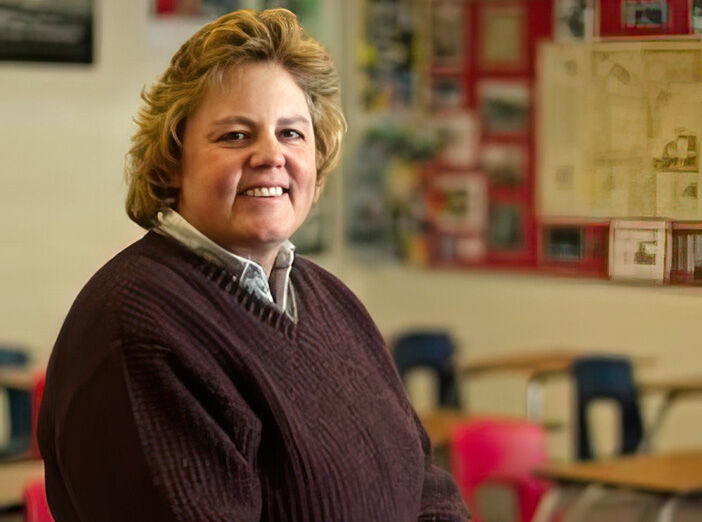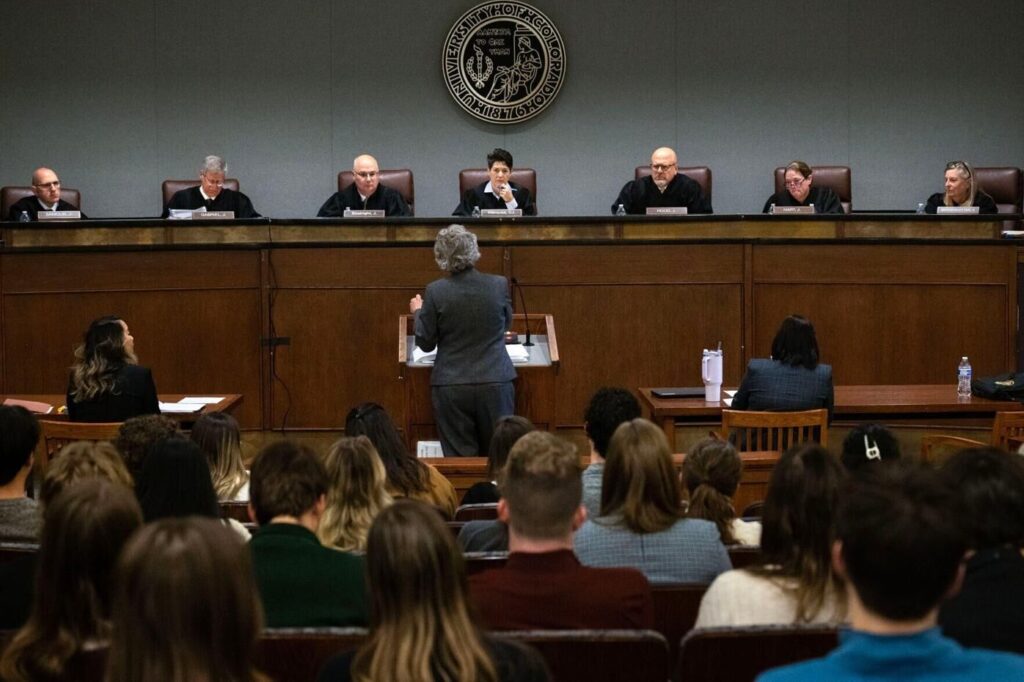The Colorado Springs area is on track to reach 1 million people. Will bigger be better?
Colorado Springs is on the growth highway — and the road sign up ahead reads 1 million people.
By 2049, El Paso County — which includes the Springs, smaller cities and towns such as Calhan, Fountain and Monument, and unincorporated areas like Falcon and Security-Widefield — will have grown to a population of 1,002,683, according to the latest forecasts by the Colorado State Demography Office, which tracks population and demographic trends.
That seven-figure milestone will come even sooner for Colorado Springs’ metropolitan statistical area or MSA, a Census Bureau-defined area that combines El Paso and neighboring Teller County to the west. The Colorado Springs MSA will tip the scales at 1,003,957 in 2045, the Demography Office estimates.
“Our growth and hitting a million in population is not surprising given our outstanding quality of life in the Pikes Peak region and our economic and employment opportunities,” Andrew Gunning, executive director of the Pikes Peak Area Council of Governments planning agency, said via email.
A population of 1 million is to be expected based on trends over the last 20 years, when the Colorado Springs area added roughly 9,000 to 10,000 people in some of those years, local economist Tatiana Bailey said.
More people, more cars: As El Paso County grows, planners grapple with traffic ‘pain points’
“When you think about Colorado Springs, suddenly we’re not the little stepchild anymore,” Bailey said, referring to the city’s status as an ascending population center behind the Denver metro area.
OK, so it’s no shock that Colorado Springs is on track to reach 1 million people.
But what then? Will bigger be better?
Some community leaders, perhaps predictably, remain bullish about a Springs-area future of 1 million people, though they acknowledge challenges such as ensuring water resources are plentiful for sprawling neighborhoods, building roads and key infrastructure pieces to accommodate growing numbers of motorists and providing enough housing — especially at affordable prices — for those who want and need it.
“They’ll largely be the same kind of issues that we deal with today,” said former Colorado Springs Mayor John Suthers.
City and community leaders already have sought to confront some long-term concerns, he said.
Water-use technology that has been a focus of Colorado Springs Utilities, for example, will be a “dramatic game changer” that could lead to gains in the reuse of water, Suthers said.
“In 20 years, we will get twice as much use out of our water as we do today through reuse technology,” Suthers said. “You won’t know the difference. The water will still be as fantastic as it is today. That’s just the nature of the way the technology is moving.”
For transportation needs, the combination of two voter-approved funding mechanisms — the Pikes Peak Rural Transportation Authority that pays for road construction and a special city sales tax dedicated to road repairs — puts Colorado Springs in an advantageous position, Suthers said. A stormwater fee to fund construction, maintenance and operation of the city’s stormwater system also has been crucial, he said.
“But growth means demands on infrastructure, and you’ve got to keep up,” Suthers said. “If you don’t, it’s going to be problematic.”
Toward that goal, the Pikes Peak Area Council of Governments is working to create a long-range transportation plan though 2050, Gunning said. That plan, which will be the product of public feedback and input from local jurisdictions, will aim to “generate a balanced plan that addresses all modes of travel to meet a growing community and our changing demographics,” he said. It’s expected to be completed by the end of 2024; part of that planning process will involve working with local communities to assemble a land-use forecast to show where growth and new development will take place, Gunning added.
Meanwhile, some real estate developers — a frequent target of growth critics — say they’ll attempt to keep up with population forecasts with a mix of projects that address residential and commercial demand, yet employ smart-growth strategies.
As Colorado Springs grows, 20-somethings are the fastest growing cohort
Those strategies include the development of high-density projects — with a mix of housing types and greater walkability — around and near employment centers to create self-contained communities that eschew long commutes, said Craig Dossey, former executive director of El Paso County’s Planning and Community Development Department and now president of Vertex Consulting Services, a Springs-based land-planning firm.
He’s working with the developers of Karman Line, a 1,834-acres project proposed east of Curtis Road and south of Schriever Space Force Base. The project’s developers are seeking annexation to Colorado Springs, which would stretch the city’s boundaries beyond the Banning Lewis Ranch that makes up roughly the eastern one-third of the Springs and itself is envisioned for decades worth of residential and commercial growth.
Karman Line would create a “mutually supportive community,” in which land uses work hand-in-hand with each other, according to a proposal submitted to city planners. Commercial, office and light industrial elements would allow “live-work opportunities” for residents; housing choices would include single-family and multifamily options, while residents would have shopping, restaurants, service-oriented businesses and employment centers close by.
Some mixed-use, vertical development — a strategy within the city’s 2019 comprehensive plan update, known as PlanCOS, that calls for “stacking” various uses on top of each other in areas of limited space — also would be part of Karman Line.
In effect, Karman Line would offer self-contained land uses near Schriever, which already is a major employer and expected to grow, Dossey said.
While the project might seem farther out from Colorado Springs’ existing boundaries, fewer parcels are available than, say, 20 years ago for high-density, mixed-use projects, he said. At the same time, expensive land and construction costs have led developers to look for available areas, even if they lie outside the city, he added.
“As some of our employment sectors continue to grow, there’s going to be demands on housing to suit those employment bases, in the tech area in particular,” Dossey said. “And what do those workers want? A lot of them don’t want to commute 45 minutes. They want to work near their employment location.
“Look at the Amazon facility (near the Colorado Springs Airport),” he added. “You’re seeing a lot of housing going in that area. I think that’s where the focus is going to go — densification around some of those big employment areas, the airport, around the military installations like Karman Line is going to be offering.”
Developer Danny Mientka of The Equity Group and a Colorado Springs native who grew up in the 1960s near Constitution Avenue, said he remembers when downtown was the focal point of city life for shopping, dining, medical needs and the like.
But like many cities, Colorado Springs’ downtown gave way to suburban developments and master-planned communities, which took hold over several decades and pushed the city to the north, east and northeast. Those developments, Mientka said, provided sorely needed residential and commercial opportunities for area residents and businesses, which have benefited Colorado Springs as a whole.
Mientka has his own project planned on the Springs’ east edge; his 260-acre Reagan Ranch residential and commercial project, will be developed at U.S. 24, Colorado 94 and Marksheffel Road.
He envisions Reagan Ranch also providing residential and commercial uses to serve employment centers such as Schriever and nearby Peterson Space Force Base.
Its mix of housing would include about 1,200 single-family homes, townhomes, apartments and accessory dwelling units, while also setting aside land for commercial and industrial uses. Mientka also plans the Crossroads shopping center near U.S. 24 and Colorado 94.
“Schriever is one of the most important bases in the United States and they lack all services, housing, etc., and I think our Reagan Ranch and retail development, Crossroads … will be the center of gravity for the next 20 years,” Mientka said. “Ultimately, housing will be supported along Highway 94 just given the size of Schriever and the growth that Schriever is likely to experience.”
As the area marches toward 1 million people, however, also expect more infill projects in existing parts of the Springs, Mientka said. Such projects were a goal in Colorado Springs’ updated comprehensive plan.
5 growth hotspots around Colorado Springs: A closer look
The surge of apartment construction in downtown is an example, Mientka said; the Downtown Partnership advocacy group has estimated 2,000 apartments will open in the next two years, bringing more housing to an established area, adding nearby amenities and avoiding suburban sprawl.
“With urbanization comes some things that people find very beneficial,” said Suthers, the city’s former mayor. “The transformation of downtown Colorado Springs over the last year has been a big positive. It’s a place where people want to live. They didn’t used to want to live (there). It’s got a lot of amenities downtown. We’ve got a stadium (Weidner Field), we’ve got an arena (Ed Robson Arena), we’ve got a museum (the U.S. Olympic & Paralympic Museum). Those projects are going to lead to more hotels down here. I think that’s a positive.”
Mientka plans his own apartment project a few blocks south of downtown as part of the city’s South Nevada Avenue redevelopment project. His seven-story building, with up to 400 units, would go up on 4.5 acres between St. Elmo and Ramona avenues, west of Nevada and a new Sprouts Farmers Market grocery store. (The City Council has been sued over its decision to rezone the site and authorize the apartment project; the suit, brought by Broadmoor resident and former Gazette owner Tim Hoiles, alleges the rezoning poses public safety and health risks.)
Infill projects, however, need to be developed on sites that are accessible to retail and public transportation, Mientka said. His South Nevada project is on a bus line and within a few minutes walk to Sprouts, Natural Grocers, Safeway and several other businesses along the corridor; that proximity eliminates the need for a crosstown drive to Powers Boulevard, he said.
“The future will be, in my opinion, more infill and it will necessarily need to be walkable to public transportation,” Mientka said. “That will drive demand for public transportation, which will then allow it to mature and improve. … At the end of the day, they want community. They want to live where other people live. They want to walk to restaurants and retail and services. Or downtown, they’ll scooter.”
Whether it’s more infill housing or residential developments that stretch Colorado Springs’ boundaries, the area must add more and affordable housing as its population grows, said Bailey, the economist who also heads Data-Driven Economic Strategies, a Springs-based nonprofit.
An increase in jobs will parallel the area’s population growth over the next few decades, she said, especially in seven key sectors: health and social assistance; professional, scientific and technical services; education; hospitality and food service; construction; retail; and manufacturing. Through 2032, Bailey forecasts a combined 45,235 employees added in those industries.
Yet, as the Springs area grows toward 1 million people, it must overcome a lack of housing and ensure that it has qualified workers, challenges that other cities also face, Bailey said.
“To the extent we can accommodate that growth from a sort of personal and household perspective,” Bailey said, “businesses will come. They will come and they will stay if they’ve got a good workforce and decent tax laws and all of that. I don’t worry as much about attracting businesses at this point as much as I worry about having qualified workers who can afford to live here and want to stay here.”
Some of those businesses were attracted to Colorado Springs in the past because of its smaller-town feel, said Craig Anderson, a senior broker and principal with NAI Highland, a local commercial real estate firm.
A bigger population now will help the Springs get on the radar of a larger pool of employers who will consider the area for expansion or relocation, yet the city won’t be so big that it loses its attractiveness, especially when compared with other metro areas, he said.
“My assumption is that the country continues to urbanize,” Anderson said. “There aren’t too many cities that are shrinking. … So the assumption is, when we get 1 million, Austin (Texas) will be at 3 million and Dallas will be whatever. I just think that we still offer a smaller market, but with enough population to help these employers.”
And while the city’s population gains might attract employers, others will take note of the city’s quality of life, said Dossey, the former county planning director. Colorado Springs has garnered top rankings for several years running from U.S. News & World Report as a desirable place to live.
Of course, the area will face challenges to maintain its quality of life as it approaches a population of 1 million, Dossey said.
“For instance, like Highway 24,” Dossey said of the road that leads west to Teller County and central Colorado. “One of the things that a lot of us enjoy is the ability to access the mountains and get into the national forest and other areas beyond that. With population growth comes more cars traveling on that same road. There’s always going to be that increased pressure on certain services, certain infrastructure.”
Yet, Dossey said he doesn’t expect the area to lose its quality of life. For instance, growth will enhance trail and recreational opportunities in new areas, such as near the site of Springs Utilities’ planned Gary Bostrom Reservoir, south of Karman Line.
“That’s not going to add additional stress to Monument Valley Park,” Dossey said. “Those people (new residents) are going to frequent parks somewhere else, closer to home.”
Not everyone is optimistic about the area’s future when it reaches 1 million people, however.
Dave Gardner, considered by many as the Pikes Peak region’s most outspoken growth critic and who operates the GrowthBusters website, is dubious that more jobs, businesses and an expansive economy will make the Springs and El Paso County a better place to live.
“We’ve all gotten so use to this ‘more of everything must be good’ paradigm,” Gardner said. “If there are 1 million people, there will be more jobs, more businesses, more gross metropolitan product. And this underlying assumption that, wow, that’s a good economy because it’s bigger. I just question that, especially when you’ve filled up the planet. At some point a bigger economy isn’t a better economy. And I think we passed that point long ago. But most people haven’t caught on to that.”
Gardner, though, questions if the area will actually reach the 1 million population milestone to begin with because of global threats posed by climate change. He cited a news story about a recent “state of the climate” report, which laid out climate change’s dire consequences and was endorsed by thousands of researchers in more than 160 countries.
“I’m not even imagining what life might be like in Colorado Springs or El Paso County at 1 million people,” he said. “To me, it looks highly unlikely we’re going to get there. The next two decades are going to be very grim and population growth is going to stop a lot sooner than people think.”
Suthers, a lifelong Springs resident, said he’s well aware of the criticisms about the area’s growth. Yet, additional jobs and businesses, cultural and entertainment opportunities, restaurants and the like are a realistic outcome of more people wanting to call Colorado Springs home.
“I got a big kick out of it, when I’d go to town hall meetings as mayor, and literally people that arrived in the last year would tell me, ‘gee mayor, we need a growth moratorium,'” Suthers said, who completed his second and last term as mayor in June. “Well, that’s not, for the most part, how government works. Growth moratoriums don’t work. Artificial limits on growth don’t work.”
Colorado Springs’ population boom puts strain on local law enforcement and social services
Some will be turned off by what they believe will be an erosion of their quality of life because of too many people and will decide Colorado Springs isn’t for them, Suthers said. Others will continue to be attracted by what the area offers, he said.
For the most part, Suthers said, he expects more people will want to live here, not less.
Transplants from New Jersey and elsewhere who live in outlying areas, for example, will wake up each morning, look at Pikes Peak “and think it’s the greatest place they’ve ever lived,” he said.
“That’s what’s so fascinating to me,” Suthers said. “I go to areas of Colorado Springs out there that I just can’t believe are now developed. And people just love it. They’re way out there. But everybody’s got a view of Pikes Peak and they just think they’ve died and gone to heaven.
“They sound as enthusiastic as my parents did when they moved here in 1946,” he said. “I keep reminding people: as long as people believe that this is an incredible upgrade in their quality of life, they’re going to continue to come here.”










